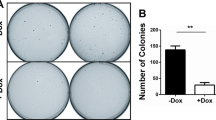Abstract
Retinoic acid (RA) is a signaling molecule that plays a pivotal role in major cellular processes and vertebrate development. RA action is mediated by specialized transcription factors, the nuclear RA receptors (RARs), which regulate the transcription of genes containing a RA-responsive element (RARE). Here we demonstrate that the genes for the RA-receptor RARβ2 and the cytochrome P450 RA-specific hydrolase Cyp26a1 involved in RA catabolism are coordinately regulated by RA. We found that both RARβ2 and Cyp26a1 genes are epigenetically silenced in the absence of DNA methylation in RAC65, a P19 embryocarcinoma cell line derivative carrying a dominant-negative RARα mutant and resistant to the growth-inhibitory and differentiation effects of RA. In response to RA, RARβ2 transcription is epigenetically regulated by RARα. Similarly, we found that Cyp26a1 transcription is epigenetically regulated by RARβ2. Knocking down RARβ2 transcription by RNA interference in wild-type P19 cells, with an intact RARα, induced Cyp26a1 transcriptional repression in the absence of DNA methylation. Concomitantly, cells developed RA resistance and did not undergo RA-induced neuron differentiation. Apparently, RARα, RARβ2 and Cyp26a1 are components of a RA-regulated gene network. Factors affecting an upstream gene of the network can trigger repressive chromatin changes – which are propagated in a domino fashion – at downstream genes of the network. This study also shows that chromatin inactivity, and consequent transcriptional silencing, can be achieved in the absence of DNA methylation.
This is a preview of subscription content, access via your institution
Access options
Subscribe to this journal
Receive 50 print issues and online access
$259.00 per year
only $5.18 per issue
Buy this article
- Purchase on Springer Link
- Instant access to full article PDF
Prices may be subject to local taxes which are calculated during checkout





Similar content being viewed by others
Accession codes
References
Arney KL, Fisher AG . (2004). J Cell Sci 117: 4355–4363.
Baylin S, Bestor TH . (2002). Cancer Cell 1: 299–305.
Berger SL . (2002). Curr Opin Genet Dev 12: 142–148.
Chambon P . (1996). FASEB J 10: 940–954.
Chiba H, Clifford J, Metzger D, Chambon P . (1997). Mol Cell Biol 17: 3013–3020.
Costa SL, McBurney MW . (1996). Exp Cell Res 225: 35–43.
Di Croce L, Raker VA, Corsaro M, Fazi F, Fanelli M, Faretta M et al. (2002). Science 295: 1079–1082.
Dilworth FJ, Chambon P . (2001). Oncogene 20: 3047–3054.
Dobbs-McAuliffe B, Zhao Q, Linney E . (2004). Mech Dev 121: 339–350.
Edwards MK, McBurney MW . (1983). Dev Biol 98: 187–191.
Grignani F, Valtieri M, Gabbianelli M, Gelmetti V, Botta R, Luchetti L et al. (2000). Blood 96: 1531–1537.
He LZ, Guidez F, Tribioli C, Peruzzi D, Ruthardt M, Zelent A et al. (1998). Nat Genet 18: 126–135.
Jones-Villeneuve EM, McBurney MW, Rogers KA, Kalnins VI . (1982). J Cell Biol 94: 253–262.
Jones-Villeneuve EM, Rudnicki MA, Harris JF, McBurney MW . (1983). Mol Cell Biol 3: 2271–2279.
Kruyt FA, van der Veer LJ, Mader S, van den Brink CE, Feijen A, Jonk LJ et al. (1992). Differentiation 49: 27–37.
Laudet V, Gronemeyer H . (2002). The Nuclear Receptor Facts Book. Academic Press: London, pp. 6–21.
Martin GR, Evans MJ . (1975). Proc Natl Acad Sci USA 72: 1441–1445.
Napoli JL . (1999). Prog Nucleic Acid Res Mol Biol 63: 139–188.
Ozpolat B, Mehta K, Tari AM, Lopez-Berestein G . (2002). Am J Hematol 70: 39–47.
Pratt MA, Kralova J, McBurney MW . (1990). Mol Cell Biol 10: 6445–6453.
Ray WJ, Bain G, Yao M, Gottlieb DI . (1997). J Biol Chem 272: 18702–18708.
Sirchia SM, Ferguson AT, Sironi E, Subramanyan S, Orlandi R, Sukumar S et al. (2000). Oncogene 19: 1556–1563.
Sirchia SM, Ren M, Pili R, Sironi E, Somenzi G, Ghidoni R et al. (2002). Cancer Res 62: 2455–2461.
Sonneveld E, van den Brink CE, Tertoolen LG, van der Burg B, van der Saag PT . (1999). Dev Biol 213: 390–404.
White KA, Yore MM, Warburton SL, Vaseva AV, Rieder E, Freemantle SJ et al. (2003). J Biol Chem 278: 43889–43892.
Acknowledgements
We thank Dr Paul T van der Saag for kindly providing the embryocarcinoma cell lines, Drs Giulia Somenzi and MingQiang Ren for critical discussion and suggestions. This work was partially supported by a grant from the Association for Research of Childhood Cancer (AROCC) to NS.
Author information
Authors and Affiliations
Corresponding author
Rights and permissions
About this article
Cite this article
Pozzi, S., Rossetti, S., Bistulfi, G. et al. RAR-mediated epigenetic control of the cytochrome P450 Cyp26a1 in embryocarcinoma cells. Oncogene 25, 1400–1407 (2006). https://doi.org/10.1038/sj.onc.1209173
Received:
Revised:
Accepted:
Published:
Issue Date:
DOI: https://doi.org/10.1038/sj.onc.1209173
Keywords
This article is cited by
-
Activation of Akt pathway by transcription-independent mechanisms of retinoic acid promotes survival and invasion in lung cancer cells
Molecular Cancer (2013)
-
A coordinated phosphorylation cascade initiated by p38MAPK/MSK1 directs RARα to target promoters
The EMBO Journal (2009)
-
Trichloroethylene and Trichloroacetic Acid Regulate Calcium Signaling Pathways in Murine Embryonal Carcinoma Cells P19
Cardiovascular Toxicology (2008)
-
Functional pharmacogenetics/genomics of human cytochromes P450 involved in drug biotransformation
Analytical and Bioanalytical Chemistry (2008)
-
A distinct epigenetic signature at targets of a leukemia protein
BMC Genomics (2007)



